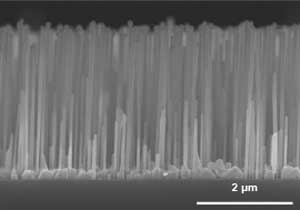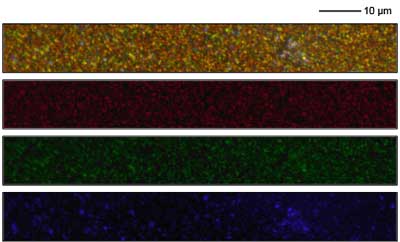Jun 18, 2020
(Nanowerk Spotlight) Vertical semiconductor nanowire arrays are a promising material for retinal prostheses, which could help restore the eyesight of people suffering from severe retinal diseases. These nanowires could also be used to fabricate bio-inspired photoreceptors and lightweight, highly efficient photovoltaics.
"Much research on the realization of next-generation optoelectronics based on semiconductor vertical nanowires has focused on the collective optical feature of nanowires and device performance, which could be observed and manifested at macroscopic scales," Young Min Song, an Associate Professor in the School of Electrical Engineering and Computer Science at Gwangju Institute of Science and Technology, explains to Nanowerk. "Although the individual resonance of combined nanowires triggers the macroscopic observable optical characteristics, the detailed photonic phenomena in nanowire arrays have been barely studied so far."
In fact, novel and intriguing photonic events – such as intense absorption, scatting, and wavelength-selectivity – result from the individual resonance of nanowires, which is called guided (or leaky) mode.
In new work by Song's group, published in Advanced Optical Materials ("Selective and Sensitive Photon Sieve Based on III–V Semiconductor Nanowire Forest Fabricated by Lithography-Free Process"), the scientists present theoretical and experimental studies on the microscopic optical behavior of highly dense and randomly distributed nanowire arrays embedded in a transparent polymer, which they termed selective and sensitive photon sieve (SSPS).
They found that random and dense III-V nanowire forests can have distinguishable nanoscopic optical resonances responding to different incident photons under the condition of certain geometrical parameters.
"Our experimental observations also successfully support our computational results by showing the unique spectral images depending of wavelengths including blue, green, red, and near-infrared colors," Song points out.
 SEM image of a vertical nanowire array. (Reprinted with permission by Wiley-VCH Verlag)
In the past few years, Song's group has focused on the development of semiconductor nanowire-based optical filters and bio-inspired imaging devices.
"Based on our previous research, we were naturally interested in the spectral response of vertical nanowire arrays, which is analogous to biological retinal cells," he says. "We thoroughly investigated the optical events of vertical nanowire arrays by growing samples without the use of nanolithographical processes for affordability and embedding the samples into transparent polymer."
The team also developed a design guideline for using vertically aligned III-V nanowire forests as artificial photoreceptors. This research could contribute to the progress in developing artificial eyes and bio-inspired high-resolution cameras.
Particularly attractive for retinal prosthesis applications is the high photon selectivity and sensitivity within a wide-band range from ultraviolet, visible, and near-infrared. Moreover, the softness of nanowires and encapsulating polymer could allow the integration of prosthetic devices with damaged or blind retinas.
SEM image of a vertical nanowire array. (Reprinted with permission by Wiley-VCH Verlag)
In the past few years, Song's group has focused on the development of semiconductor nanowire-based optical filters and bio-inspired imaging devices.
"Based on our previous research, we were naturally interested in the spectral response of vertical nanowire arrays, which is analogous to biological retinal cells," he says. "We thoroughly investigated the optical events of vertical nanowire arrays by growing samples without the use of nanolithographical processes for affordability and embedding the samples into transparent polymer."
The team also developed a design guideline for using vertically aligned III-V nanowire forests as artificial photoreceptors. This research could contribute to the progress in developing artificial eyes and bio-inspired high-resolution cameras.
Particularly attractive for retinal prosthesis applications is the high photon selectivity and sensitivity within a wide-band range from ultraviolet, visible, and near-infrared. Moreover, the softness of nanowires and encapsulating polymer could allow the integration of prosthetic devices with damaged or blind retinas.
 Different spectral response of the selective and sensitive photon sieve (SSPS) to (from top) white, red, green, and blue light. (Image: Song Research Group)
In this stage of their work, the researchers demonstrated that random and dense nanowire forests spectrally distinguish the incident photons in individual nanowires with high absorptivity. The next step, in order to develop artificial photoreceptors, is the connection of metal electrodes to each nanowire in order to read individual electrical signals from them.
"We require a novel electrical connection and data readout strategy in order for us to build functional devices," Song concludes. "Individual electrical connection with tremendously many nanowires is not an easy task, but we believe that cutting-edge complementary metal-oxide-semiconductor (CMOS) circuit techniques, enabling sub-micron meter pitch, is a potential solution for this."
By
Michael is author of three books by the Royal Society of Chemistry:
Nano-Society: Pushing the Boundaries of Technology,
Nanotechnology: The Future is Tiny, and
Nanoengineering: The Skills and Tools Making Technology Invisible
Copyright ©
Nanowerk
Different spectral response of the selective and sensitive photon sieve (SSPS) to (from top) white, red, green, and blue light. (Image: Song Research Group)
In this stage of their work, the researchers demonstrated that random and dense nanowire forests spectrally distinguish the incident photons in individual nanowires with high absorptivity. The next step, in order to develop artificial photoreceptors, is the connection of metal electrodes to each nanowire in order to read individual electrical signals from them.
"We require a novel electrical connection and data readout strategy in order for us to build functional devices," Song concludes. "Individual electrical connection with tremendously many nanowires is not an easy task, but we believe that cutting-edge complementary metal-oxide-semiconductor (CMOS) circuit techniques, enabling sub-micron meter pitch, is a potential solution for this."
By
Michael is author of three books by the Royal Society of Chemistry:
Nano-Society: Pushing the Boundaries of Technology,
Nanotechnology: The Future is Tiny, and
Nanoengineering: The Skills and Tools Making Technology Invisible
Copyright ©
Nanowerk
 SEM image of a vertical nanowire array. (Reprinted with permission by Wiley-VCH Verlag)
In the past few years, Song's group has focused on the development of semiconductor nanowire-based optical filters and bio-inspired imaging devices.
"Based on our previous research, we were naturally interested in the spectral response of vertical nanowire arrays, which is analogous to biological retinal cells," he says. "We thoroughly investigated the optical events of vertical nanowire arrays by growing samples without the use of nanolithographical processes for affordability and embedding the samples into transparent polymer."
The team also developed a design guideline for using vertically aligned III-V nanowire forests as artificial photoreceptors. This research could contribute to the progress in developing artificial eyes and bio-inspired high-resolution cameras.
Particularly attractive for retinal prosthesis applications is the high photon selectivity and sensitivity within a wide-band range from ultraviolet, visible, and near-infrared. Moreover, the softness of nanowires and encapsulating polymer could allow the integration of prosthetic devices with damaged or blind retinas.
SEM image of a vertical nanowire array. (Reprinted with permission by Wiley-VCH Verlag)
In the past few years, Song's group has focused on the development of semiconductor nanowire-based optical filters and bio-inspired imaging devices.
"Based on our previous research, we were naturally interested in the spectral response of vertical nanowire arrays, which is analogous to biological retinal cells," he says. "We thoroughly investigated the optical events of vertical nanowire arrays by growing samples without the use of nanolithographical processes for affordability and embedding the samples into transparent polymer."
The team also developed a design guideline for using vertically aligned III-V nanowire forests as artificial photoreceptors. This research could contribute to the progress in developing artificial eyes and bio-inspired high-resolution cameras.
Particularly attractive for retinal prosthesis applications is the high photon selectivity and sensitivity within a wide-band range from ultraviolet, visible, and near-infrared. Moreover, the softness of nanowires and encapsulating polymer could allow the integration of prosthetic devices with damaged or blind retinas.
 Different spectral response of the selective and sensitive photon sieve (SSPS) to (from top) white, red, green, and blue light. (Image: Song Research Group)
In this stage of their work, the researchers demonstrated that random and dense nanowire forests spectrally distinguish the incident photons in individual nanowires with high absorptivity. The next step, in order to develop artificial photoreceptors, is the connection of metal electrodes to each nanowire in order to read individual electrical signals from them.
"We require a novel electrical connection and data readout strategy in order for us to build functional devices," Song concludes. "Individual electrical connection with tremendously many nanowires is not an easy task, but we believe that cutting-edge complementary metal-oxide-semiconductor (CMOS) circuit techniques, enabling sub-micron meter pitch, is a potential solution for this."
By
Michael is author of three books by the Royal Society of Chemistry:
Nano-Society: Pushing the Boundaries of Technology,
Nanotechnology: The Future is Tiny, and
Nanoengineering: The Skills and Tools Making Technology Invisible
Copyright ©
Nanowerk
Different spectral response of the selective and sensitive photon sieve (SSPS) to (from top) white, red, green, and blue light. (Image: Song Research Group)
In this stage of their work, the researchers demonstrated that random and dense nanowire forests spectrally distinguish the incident photons in individual nanowires with high absorptivity. The next step, in order to develop artificial photoreceptors, is the connection of metal electrodes to each nanowire in order to read individual electrical signals from them.
"We require a novel electrical connection and data readout strategy in order for us to build functional devices," Song concludes. "Individual electrical connection with tremendously many nanowires is not an easy task, but we believe that cutting-edge complementary metal-oxide-semiconductor (CMOS) circuit techniques, enabling sub-micron meter pitch, is a potential solution for this."
By
Michael is author of three books by the Royal Society of Chemistry:
Nano-Society: Pushing the Boundaries of Technology,
Nanotechnology: The Future is Tiny, and
Nanoengineering: The Skills and Tools Making Technology Invisible
Copyright ©
Nanowerk
Nanowerk Newsletter
Get our Nanotechnology Spotlight updates to your inbox!
Become a Spotlight guest author! Join our large and growing group of guest contributors. Have you just published a scientific paper or have other exciting developments to share with the nanotechnology community? Here is how to publish on nanowerk.com.

